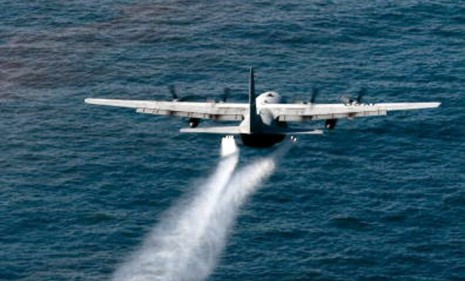BP's chemical 'carpet-bombing' of the Gulf: How much damage?
We're tantalizingly close to entering the clean-up phase of the record Gulf oil spill. Too bad oil isn't the only pollutant we have to deal with

As BP nears what everyone hopes are is the final phase of permanently sealing its blown-out Macondo well, the U.S. government now estimates that 4.9 million barrels, or 206 million gallons, of crude has flowed into the Gulf since April 20 — making this the largest accidental oil spill ever, anywhere. But as efforts shift to the cleanup, another big question looms: How much toxic dispersant did BP dump into the ocean and how much damage will it do to the environment? (Watch a CNN report about the chemical spillage)
Don't we know how much dispersant BP used?
BP says it used a total of 1.8 million gallons of chemical dispersants — products that break the oil into smaller, more-easily dissolved droplets — during the nearly three months when its well was leaking. But Rep. Ed Markey (D-MA) has questioned "the validity of those numbers," saying on July 31 that a new congressional report shows "BP carpet-bombed the ocean with these chemicals, and the Coast Guard allowed them to do it."
The Week
Escape your echo chamber. Get the facts behind the news, plus analysis from multiple perspectives.

Sign up for The Week's Free Newsletters
From our morning news briefing to a weekly Good News Newsletter, get the best of The Week delivered directly to your inbox.
From our morning news briefing to a weekly Good News Newsletter, get the best of The Week delivered directly to your inbox.
What does Markey mean?
The Coast Guard and the EPA issued a directive May 25 ordering BP to limit the application of its preferred dispersant, Corexit 9500, underwater and to cease dumping it on the surface except in "rare cases." But Markey says that, even after that order was issued, the Coast Guard rubber-stamped all of BP's dozens of exemption requests for continued surface use of Corexit. He also says that BP grossly misled Congress about the quantity of dispersant it was applying.
How do BP and the Coast Guard respond?
BP says it "followed the direction" of the Coast Guard and was "in regular communication" with the EPA over its use of Corexit. Coast Guard Adm. Thad Allen said that U.S. field commanders allowed surface application on a case-by-case basis, and had reduced dispersant use by 72 percent from the May 24 high of 70,000 gallons, "generally" meeting the 75 percent reduction goal set by the EPA. The EPA, Coast Guard, and BP all defended the use of Corexit as the lesser of two evils.
A free daily email with the biggest news stories of the day – and the best features from TheWeek.com
Just how toxic is Corexit?
No one is entirely sure in these quantities. Sen. Bill Nelson (D-FL) said Monday that the chemicals have created "a toxic brew deep beneath the surface" that might ultimately do more damage than if the oil had just risen to the surface. The EPA, though, reported Monday that its latest tests showed that the mix of Corexit and crude from the spill was "moderately toxic," and no more poisonous than the oil by itself.
So was using dispersant better than letting the oil flow?
"That's a debate with no right answer," says Texas A&M Gulf expert Larry McKinney. It's generally agreed that the dispersant has (at least so far) reduced the amount of oil that's reached shore and damaged fragile marshlands — and that we don't know the long-term effects of this much Corexit. EPA research chief Paul Anastas says using Corexit "seems to be a wise decision" from the present vantage point. But as much as "I hate to sound like a movie tagline," says Time's Bryan Walsh, given the big unknowns, "the battle under water is just beginning" in the Gulf spill.
Sources: Christian Science Monitor, NY Daily News, Time (2), New York Times, Scientific American, LA Times, Mother Jones, Miami Herald, Globe & Mail
-
 A luxury walking tour in Western Australia
A luxury walking tour in Western AustraliaThe Week Recommends Walk through an ‘ancient forest’ and listen to the ‘gentle hushing’ of the upper canopy
-
 What Nick Fuentes and the Groypers want
What Nick Fuentes and the Groypers wantThe Explainer White supremacism has a new face in the US: a clean-cut 27-year-old with a vast social media following
-
 5 highly amusing cartoons about rising health insurance premiums
5 highly amusing cartoons about rising health insurance premiumsCartoon Artists take on the ACA, Christmas road hazards, and more